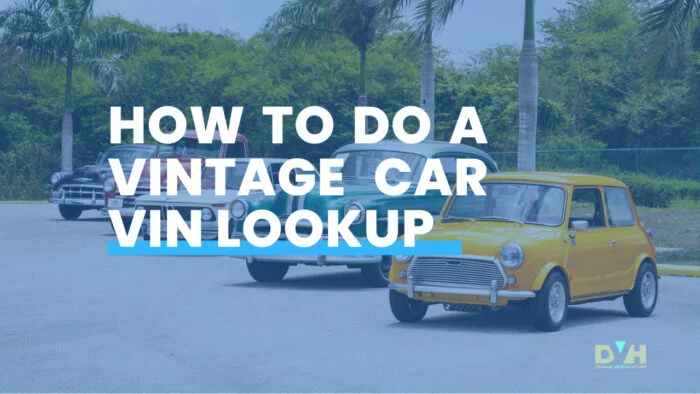Car enthusiasts are dedicated explorers interested in discovering and sometimes purchasing really old vehicles, such as classic or vintage cars. These cars nowadays are extremely valuable and expensive compared to regular cars because they’ve been preserved through history. Remember that they are still old cars and may have one hidden defect or history; they may have had most of their original parts replaced; and they may even have title brand records. To be on the safe side, it is recommended to carry out a classic car VIN lookup and discover the full records of the vehicle you are interested in. In this article, we will highlight the importance of a vintage car VIN lookup and the necessary steps to follow to get one.

What is a vintage car?
A vintage car is a vehicle that was manufactured even before World War II. These vehicles were introduced between 1900 and 1980 and are typically known for their unique design features, advanced engineering for their time, and historical significance. Some common sites where you can find classic cars posted for sale online include:
- – Classiccars.com
- – Hemmings.com
- – Findusedonline.com, and more
These vehicles are purchased for their rarity and are usually done by collectors or people that want to buy one in perfect condition. This is where a vintage car VIN lookup gains importance as it gives insights into vehicles that car buyers may know very little about. But what is a VIN?
What is a VIN?
A VIN (Vehicle Identification Number) is a string of letters and numbers assigned to a vehicle during manufacture. Simply put, it is a code that identifies a vehicle. With the VIN of a classic car, car owners, buyers, and sellers can gain access to the records and history of the car they are interested in. By history, yes, I mean all records from manufacture to date can be accessed with a vintage car VIN check. The importance of a VIN check cannot be overstated, as it has saved a lot of car buyers huge amounts of money and protected them from car scams.
The VIN number of a classic car has no specific length, as manufacturers were free to place these stamps on their vehicles according to their own jurisdiction. Some vintage VINs are 5 digits or characters in length; others are 7, 13, and so on. From 1981 on, however, there was a standardization, and the standard VIN became 17 characters in length. This doesn’t mean every other VIN number is invalid, as they are still recognized by the government even today. So what does a vintage VIN look like?
What information is contained in a classic VIN?
A VIN number is a unique identifier that acts like a key to a warehouse of vehicle information. With the VIN, you can gain access to:
- – Accident records
- – Accurate vehicle specifications
- – Damage records
- – Auction records with more than 10 photos
- – Sales history
- – Service records
- – Maintenance records
- – Lien and loan records
- – Ownership history
- – Title-brand records
- – Market value
- – Accurate mileage records, and more
ALSO READ: How to decode classic car VIN numbers
Importance of a vintage car VIN number lookup
As earlier mentioned, the importance of carrying out a vintage VIN check cannot be overstated, as the purchase of a reliable vehicle depends on the information collected on this vehicle through a vehicle history report. Some of the major benefits of carrying out a VIN check include:
Verifying the authenticity of the vehicle
According to the Nationwide Mutual Insurance Company, an average vintage car costs between $20,000 and $100,000. In other words, they are expensive purchases, and car buyers must be cautious before committing to such purchases. With a vehicle history report, you can verify the originality and authenticity of a vintage car before making payments. A rebuilt title, for example, found through a vehicle history report, should tell you that the vehicle may have had almost all of its parts damaged and changed.
You can also spot counterfeit or replica vehicles that have been designed to look like the original but are most definitely not.
Checking for potential fraud or theft
Are you being deceived into purchasing a stolen classic car? Well, you won’t find out until you generate a vehicle history report with the vintage car VIN check tool provided by Detailed Vehicle History. There are different ways you can identify fraudsters during car sales:
- – Take a good look at the generated vehicle history report and see if you can find theft records. If you find any, be sure to turn away from the deal, no matter how good it looks.
- – Skip to the ownership records and check the records of previous owners and their locations. If it does not tally with the information provided by the seller, know that it’s a stolen vehicle.
Want to know how to identify car fraud and thefts? Keep reading here: The Role of Car Reports in Preventing Auto Theft and Fraud
Finding out the vehicle’s market value
The market value is one detail that you need to know to avoid being overcharged at a dealership or private sale. With a vintage car vehicle history report, you will gain insights on the vehicle’s current market value and negotiate properly.
How to do a vintage car VIN lookup
Carrying out a vintage car VIN number check is as easy as placing a key in a keyhole. To carry out a VIN lookup, all you need to do is locate a good vintage car VIN lookup tool. Another problem is that there are only a few vehicle history report providers offering classic and vintage car information. Our two most recommended tools would be the Detailed Vehicle History classic car VIN check tool and the Classic Decoder vehicle history report tool.
To perform a vintage car VIN lookup, simply follow these steps:
- – Locate the VIN of your classic car: Before the standardization, VINs on vintage cars were placed on different parts of the vehicles according to the manufacturer’s design. Some of the vehicle parts you can check include:
- On a plate attached to the firewall or dashboard of the vehicle
- On the engine block or transmission
- On the frame or chassis of the vehicle
- On a plate or sticker attached to the driver’s side door or door jamb
- In the glove compartment or trunk of the vehicle
- Vehicle registration documents
- – After locating the VIN, the next step is to visit the Detailed Vehicle History website.
- – Navigate to the classic vehicle history tool.
- Fill out the provided form with the requested information.
- – Select “VIN Check.”
Carfax and most vehicle history report providers are unable to provide classic car data but with Detailed Vehicle History, you gain a unique opportunity to view the full specifications, history, and records of any vintage vehicle as well as generate a detailed vehicle history report.
ALSO READ: How to Transfer Your Auto Insurance

Tips for vintage car buyers and owners
If you are purchasing a vintage car, here are some tips that you should remember to make the most of your money:
- – Do your research: Research the make and model of the vintage car you’re interested in, including its history, specifications, and any known issues or common repairs.
- – Inspect the car carefully: When inspecting the car, look for signs of rust, wear and tear, and other issues that may impact its condition or value.
- – Get a professional inspection: Consider having the car inspected by a vintage car specialist or mechanic to identify any potential issues or concerns.
- – Check the VIN and documentation: Verify the VIN number with standard VIN check tools such as the Detailed Vehicle History or Classic Decoder VIN check tools and check the car’s documentation, including its title, registration, and maintenance records, to ensure its authenticity and history.
- – Consider the costs of ownership: Vintage cars require specialized care and maintenance, so factor in the cost of upkeep and any needed repairs when budgeting for a purchase.
For owners of vintage cars, here are some tips that could extend your vehicle’s lifespan:
- – Keep up with maintenance: If you want to keep your vintage car in good shape, then you have to carry out maintenance regularly.
- – Store the car properly: Is your car kept in a cool, dry place? Well, it should be. Make sure your vintage car is taken away from direct sunlight and try as much as possible to keep it covered to protect it from dust and debris.
- – Drive the car regularly: While vintage cars should be driven sparingly, regular use can help prevent issues caused by long periods of inactivity.
- – Keep documentation up-to-date: Make sure that all papers are up-to-date and properly stored. Documents such as the certificate of title, registration documents, and insurance papers should be kept properly in a safe place.
- – Join a vintage car club: Consider joining a vintage car club or community to connect with other enthusiasts and gain access to resources and knowledge about maintaining and restoring vintage cars.
By following these tips, vintage car buyers and owners can get the most out of their money and vehicles.










